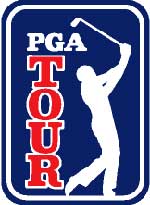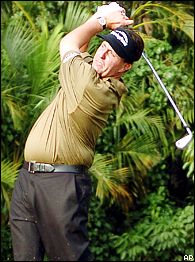PGA Tour can learn from LPGA
Updated: March 14, 2005, 1:35 PM ET
By Ron Sirak | Golf World
There are at least two ways in which the LPGA outplays the PGA Tour. One is that the women's circuit actually enforces its slow-play policy, and the other is that it makes its top players support all of its events by requiring tour competitors to appear in each tournament at least once in a four-year period.

The PGA Tour can learn some things from its LPGA counterpart.
If the PGA Tour is truly concerned about the letter – complete with suggested retail prices – sent by International Management Group to PGA Tour tournament directors suggesting that guys paid to play in Monday outings might stay around for the real tournament, then all it needs to do is adopt an LPGA-like stance regarding giving back to the hand that has fed them. And if it wants to speed up play, it needs to hit players in the scorecard, which would have a greater impact on the wallet than a fine.
In 1995, Annika Sorenstam finished tied for seventh at the LPGA Corning Classic, and she didn't return to the tiny town in upstate New York until last year. In part, Sorenstam went because of the LPGA once-every-four-years rule – a rule with which Sorenstam has some problems, by the way – but she also went as a payback for the attention she took away from Corning in 2003 when she played in the Bank of America Colonial on the PGA Tour the same week. The good news for Corning is that it won't have to wait nine years for Sorenstam to return. She won, meaning she'll be back this year as defending champion.
In 1996, the year after Sorenstam last played Corning before winning in 2004,Tiger Woods was working his way onto the PGA Tour by accepting sponsor exemptions and hoping for either a victory or to win enough money to earn his playing card. Among the events Woods was given a free pass to play that year were the Greater Milwaukee Open (now the U.S. Bank Championship), the B.C. Open and the Quad City Classic (now the John Deere Classic). He has been back to none of them. If the PGA Tour had the same rule as the LPGA, Woods would have played in each of those events since 1996 and would be getting ready for a third appearance. It would be a nice way to say "thank you," and since the players seem reluctant to do it on their own, maybe the tour needs to do it for them.
The infamous IMG letter has placed the PGA Tour between a rock and a hard place on a couple issues. First off, players have been getting paid to show up at tour events in a variety of ways for about as long as professional golf has been played. IMG is merely offering to formalize above board what has been happening under the table. Secondly, the tour could do more to strengthen the fields at second-tier events with some sort of rule requiring a certain number of appearances in a set period of time. I mean really, wasn't it more interesting to watch Woods and Phil Mickelson battle it out down the stretch at Doral in the Ford Championship than it was following Vijay Singh, Brett Wetterich and a bunch of guys named Ogilvie or Ogilvy on the closing holes? The options are two – appearance fees, as IMG suggests, or a rule, which I'm guessing the players would rebel against.
Speaking of Padraig Harrington, which we were intentionally not doing, how much entertainment value do you get out of watching paint dry? How slow is Harrington? He's so slow, they don't put him on the clock, they put him on the sundial. He's so slow his clothes go out of style during a round. He's so slow if he were on The Big Break, they'd need more than one Roman numeral to name it.
The PGA Tour has a slow-play policy, and it even enforces it – sort of. A guy who is dawdling along can be slapped with a fairly hefty fine, something in the $5,000 to $10,000 range. That may seem like a lot, but remember 77 PGA Tour players won over $1 million last year. What hurts much more than a fine – and what will really get players to move along at a quicker pace – is a two-stroke penalty. There is a provision in PGA Tour rules for a slow-play penalty to be handed out, but it is rarely used. In fact, slow-play stroke penalties have been handed out on the men's tour a grand total of zero times.
Not so on the LPGA. Last year in the Michelob ULTRA Open, Christina Kim was 3-under and in contention on Sunday when she was penalized two strokes for slow play on No. 11. That penalty ended up being worth $41,531 to Kim. It was the third two-stroke penalty handed out by the LPGA in two weeks, and the following week the tour toughened its pace-of-play policy by shaving 15 seconds off the allotted amount before hitting a shot. The message from the top at the LPGA is clearly this – we will do what is best for the overall product, and that includes making competitors play faster and making tour members support all the events by playing each one once every four years. By the way, the final group of the day at LPGA events now gets around the course 20 minutes faster.
The PGA Tour likes to say that its players are independent contractors and that it is limited in how much control it can exert over them. Still, it requires that tour members play at least 15 events a year, it requires that permission be granted before playing in an event that competes against a tour event and it requires a rights fee when a PGA Tour member plays in a televised golf event that is not a tour event. Clearly, the PGA Tour has the authority to control its players. If it wants to avoid appearance fees, it needs to get more of the best players competing in a wider range of events. And if it is serious about a quicker pace of play it needs to start assessing penalties – not fines. On these issues, the LPGA leads the PGA Tour, 2-up.
Ron Sirak is the executive editor of Golf World magazine
